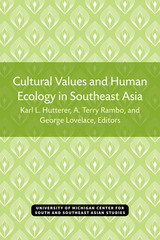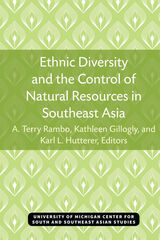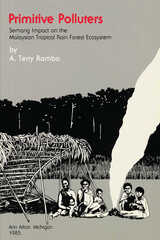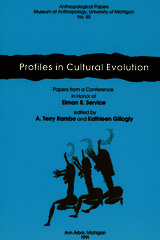4 books about Rambo, A. Terry

Cultural Values and Human Ecology in Southeast Asia
Karl L. Hutterer, A. Terry Rambo, and George Lovelace, Editors
University of Michigan Press, 1981
Ecologists have long based their conceptual frameworks in the natural sciences. Recently, however, they have acknowledged that ecosystems cannot be understood without taking into account human interventions that may have taken place for thousands of years. And for their part, social scientists have recognized that human behavior must be understood in the environment in which it is acted out. Researchers have thus begun to develop the area of “human ecology.” Yet human ecology needs suitable conceptual frameworks to tie the human and natural together.
In response, Cultural Values and Human Ecology uses the framework of cultural values to collect a set of highly diverse contributions to the field of human ecology. Values represent an important and essential aspect of the intellectual organization of a society, integrated into and ordained by the over-arching cosmological system, and constituting the meaningful basis for action, in terms of concreteness and abstraction of content as well as mutability and permanence. Because of this balance, values lend themselves to the kinds of analyses of ecological relationships conducted here, those that demand a reasonable amount of specificity as well as historical stability.
The contributions to Cultural Values and Human Ecology are exceedingly diverse. They include abstract theoretical discussions and specific case studies, ranging across the landscape of Southeast Asia from the islands to southern China. They deal with hunting-gathering populations as well as peasants operating within contemporary nation-states, and they are the work of natural scientists, social scientists, and humanists of Western and Asian origin. Diversity in the backgrounds of the authors contributes most to the varied approaches to the theme of this volume, because differences in cultural background and academic tradition will lead to different research interests and to differences in the empirical approaches chosen to pursue given problems.
[more]

Ethnic Diversity and the Control of Natural Resources in Southeast Asia
A. Terry Rambo, Kathleen Gillogly, and Karl L. Hutterrer, Editors
University of Michigan Press, 1988
The authors consider the ways in which the high degree of ethnic diversity within the region is related to the nature of tropical Asian environments, on the one hand, and the nature of Southeast Asian political systems and the ways in which they manipulate natural resources, on the other. Rather than focus on defining the phenomenon of ethnicity, this book examines the different social evolutionary contexts in which the phenomenon is manifested.
Companion volume to Cultural Values and Human Ecology in Southeast Asia (Michigan Papers no. 27).
[more]

Primitive Polluters
Semang Impact on the Malaysian Tropical Rain Forest Ecosystem
A. Terry Rambo
University of Michigan Press, 1985
In the 1970s, A. Terry Rambo conducted fieldwork in Peninsular Malaysia with a group of Semang people. The community he studied had a seminomadic lifestyle: at times they stayed in houses or lean-tos in a village, and at other times they foraged in the surrounding rain forest for food. Rambo’s goal was to assess this group’s impact on the local environment. He found that, through domestic fires and cigarette smoking, they caused significant air pollution at the household level, but because of their small population size, they did not have much of an ecological impact.
[more]

Profiles in Cultural Evolution
Papers from a Conference in Honor of Elman R. Service
Edited by A. Terry Rambo and Kathleen Gillogly
University of Michigan Press, 1991
Presenting diverse viewpoints and topics, this collection includes the following sections:Part I presents a background on the study of cultural evolution. Part II deals with the evolution of complex societies in the tropics of South America. Part III discusses stage sequences and directionality in cultural evolution. Part IV examines the role of prime movers in cultural evolution. Part V discusses diversity and change.
[more]
READERS
Browse our collection.
PUBLISHERS
See BiblioVault's publisher services.
STUDENT SERVICES
Files for college accessibility offices.
UChicago Accessibility Resources
home | accessibility | search | about | contact us
BiblioVault ® 2001 - 2024
The University of Chicago Press









